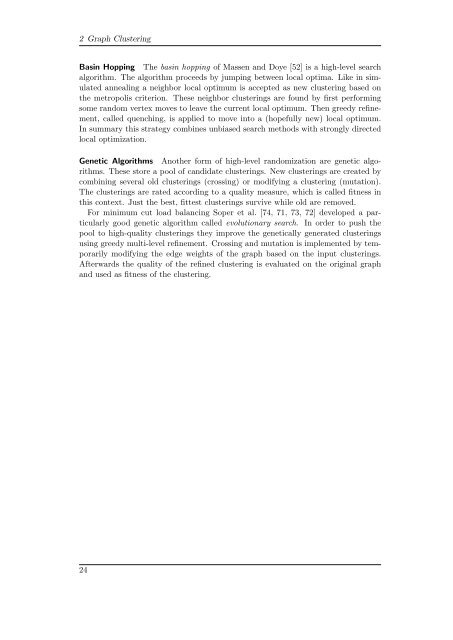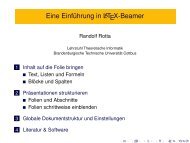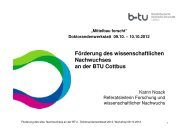Multilevel Graph Clustering with Density-Based Quality Measures
Multilevel Graph Clustering with Density-Based Quality Measures
Multilevel Graph Clustering with Density-Based Quality Measures
Create successful ePaper yourself
Turn your PDF publications into a flip-book with our unique Google optimized e-Paper software.
2 <strong>Graph</strong> <strong>Clustering</strong>Basin Hopping The basin hopping of Massen and Doye [52] is a high-level searchalgorithm. The algorithm proceeds by jumping between local optima. Like in simulatedannealing a neighbor local optimum is accepted as new clustering based onthe metropolis criterion. These neighbor clusterings are found by first performingsome random vertex moves to leave the current local optimum. Then greedy refinement,called quenching, is applied to move into a (hopefully new) local optimum.In summary this strategy combines unbiased search methods <strong>with</strong> strongly directedlocal optimization.Genetic Algorithms Another form of high-level randomization are genetic algorithms.These store a pool of candidate clusterings. New clusterings are created bycombining several old clusterings (crossing) or modifying a clustering (mutation).The clusterings are rated according to a quality measure, which is called fitness inthis context. Just the best, fittest clusterings survive while old are removed.For minimum cut load balancing Soper et al. [74, 71, 73, 72] developed a particularlygood genetic algorithm called evolutionary search. In order to push thepool to high-quality clusterings they improve the genetically generated clusteringsusing greedy multi-level refinement. Crossing and mutation is implemented by temporarilymodifying the edge weights of the graph based on the input clusterings.Afterwards the quality of the refined clustering is evaluated on the original graphand used as fitness of the clustering.24






